Entry-Level Digital SLRs
If $720 is still too rich for an interchangeable lens digital SLR there is still good news for buyers. Since 10 megapixel cameras have launched, the entry SLR is now 6 megapixels.
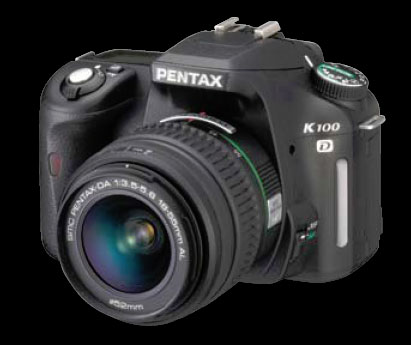
You can find the Pentax K110D with the 18-55mm lens with metal mount for around $400 for the kit after rebate. For more money you can buy the new Nikon D40 for about $600 with lens, or the Pentax K100D with body-integral anti-shake for about $510. There is even more good news in that these new low-priced entry SLR camera kits are much faster than the models they replace. In fact the Nikon and Pentax models use image processing systems similar to their 10 megapixel models. You can also find closeouts of earlier 6 megapixel models, and the savings you find will likely be substantial. Just keep in mind that the older models are often slower and have fewer features than the newer models that replaced them.
A particularly excellent buy in the entry level is the new Pentax K100D. With the Sony purchase of Minolta the entry level Maxxum 5D was discontinued and it was the only entry level SLR with body integral anti-shake. Now that Pentax has developed their own integrated ant-shake the Pentax K100D is the only entry model with built-in anti-shake that will work with any lens you can mount. Since entry SLR buyers often get just the kit lens the anti-shake really matters as it makes the most difference with slower zoom lenses like you always find included as the kit lens.
The K100D is also much faster in operation than the *ist models it replaced. Significantly, you still get 11 point autofocusing with 9 cross sensors even on the $510 K100D, ISO range to 3200 with user programmable auto ISO, and you also get a 2.5" rear LCD and top LCD like the top-line K10D. The only negative, which will be a positive for some, is that the camera uses four AA batteries instead of a rechargeable lithium-ion battery. The good news is you can find AA batteries - disposable, rechargeable, NiMH - almost anywhere, even in rural areas off the beaten track. The bad news is that the battery life with alkalines is horrible, about 100 shots in our testing. You get much better life with high-capacity rechargeable batteries, four AA or two CRV3. Users report battery life with high-capacity rechargeables that is comparable to Li-Ion with other cameras.
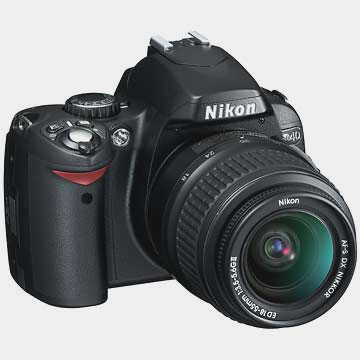
The Nikon D40 is a significant upgrade to the D50 it replaced, with a larger LCD and faster operation. However, like all the other entry SLRs you get a dimmer penta mirror instead of a brighter pentaprism viewfinder. All of the Canon Rebel cameras have used penta-mirrors instead and they have improved over time. Casual users will not likely notice the dimmer viewfinder. The D40 has just three autofocus sensors, but they are spread wide for broad AF coverage. There is no means to auto-clean the sensor and anti-shake requires dedicated and expensive lenses - a stretch for most budget buyers. If you already have Nikon autofocus lenses, however, the D40 is an easy recommendation. It is a fast and capable entry SLR.
With 10 megapixels at the top, two models at 8 megapixel resolution are also selling in the $600 range with a kit lens. The Canon Rebel XT is still an excellent performer and a real bargain at the new $600 price. It is a bit slower than the XTi, but it still provides an excellent 7-point autofocus module. The Canon 8 megapixel CMOS sensor is still the lowest noise sensor in the market, so photo quality is excellent.
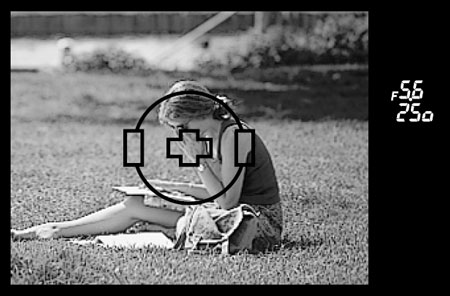
Olympus E500
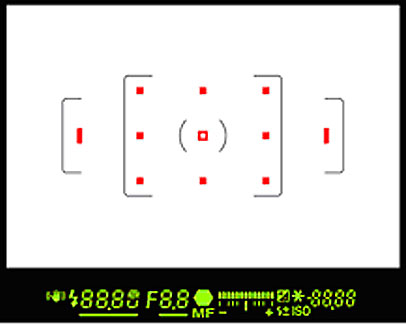
Pentax K100D/K110D
The Olympus E-500 is an 8 megapixel SLR that also sells for about $600 with the normal kit lens. The viewfinder is one of the worst we have seen - mainly because of the difficulty of building a viewfinder for the 2X multiplier of the 4/3 Olympus lens system. Olympus has also placed a pretty low priority on autofocusing sophistication. As you can see above, the 3-sensor E-500 autofocus looks rather crude beside the 11-point Pentax SAFOX AF available at the same selling price. The photo quality of the Olympus, however, is excellent as long as you don't need high ISO, and Olympus pioneered auto sensor cleaning. If you decide to go Olympus be sure to buy the 2-lens kit at just $100 more. It is an excellent value you will fully appreciate after shopping for other 4/3 mount lenses. They are generally hard to find and most are very expensive compared to offerings from the competition.
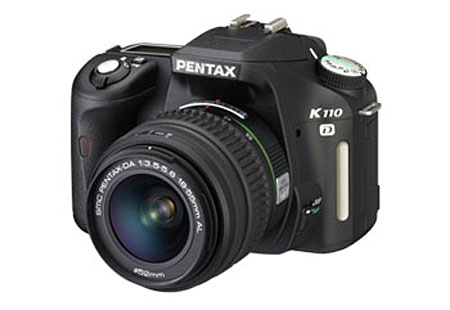
There is only one model, and a rebadged sister, available at the very bottom of the entry level market. For around $400 (after the current Pentax $50 rebate) you can buy a Pentax K110D with an 18-55mm lens (or the sister Samsung GX-1L without a rebate). It would be a mistake, however, to dismiss the K110D as basic since it is the exact same camera as the K100D without the anti-shake capabilities. That means you still get the fast 11-pont Pentax AF module and the speedier processing engine used in the K100D. The kit lens is also better build quality than you will get anywhere else for an entry SLR.
Recommendations
Pentax has some really impressive offerings at the bottom of the entry level market. The K100D is the only entry level Digital SLR with body-integral anti-shake. Since the standard kit lens is a slow zoom lens with entry level cameras, anti-shake means you can shoot sharp pictures in lower light with the Pentax K100D. The anti-shake ability also does double-duty for auto-sensor cleaning.
If you already have Canon lenses or prefer the Canon system, the Canon XT is an excellent choice at the new kit price of $600. It was a great buy at the old $900 price, and an even better buy at 2/3 the original price.
The absolute best buy in entry level digital SLRs is the Pentax K110D with the kit lens. For $400 after the current $50 rebate you get a full-featured SLR with a fast processing engine, accurate 11-point autofocusing, and even user-programmable Auto ISO to 3200. It is the exact same camera as the K100D - only the anti-shake feature is missing. The kit lens is also the only entry kit lens with a preferred metal lens mount.
If $720 is still too rich for an interchangeable lens digital SLR there is still good news for buyers. Since 10 megapixel cameras have launched, the entry SLR is now 6 megapixels.

You can find the Pentax K110D with the 18-55mm lens with metal mount for around $400 for the kit after rebate. For more money you can buy the new Nikon D40 for about $600 with lens, or the Pentax K100D with body-integral anti-shake for about $510. There is even more good news in that these new low-priced entry SLR camera kits are much faster than the models they replace. In fact the Nikon and Pentax models use image processing systems similar to their 10 megapixel models. You can also find closeouts of earlier 6 megapixel models, and the savings you find will likely be substantial. Just keep in mind that the older models are often slower and have fewer features than the newer models that replaced them.
A particularly excellent buy in the entry level is the new Pentax K100D. With the Sony purchase of Minolta the entry level Maxxum 5D was discontinued and it was the only entry level SLR with body integral anti-shake. Now that Pentax has developed their own integrated ant-shake the Pentax K100D is the only entry model with built-in anti-shake that will work with any lens you can mount. Since entry SLR buyers often get just the kit lens the anti-shake really matters as it makes the most difference with slower zoom lenses like you always find included as the kit lens.
The K100D is also much faster in operation than the *ist models it replaced. Significantly, you still get 11 point autofocusing with 9 cross sensors even on the $510 K100D, ISO range to 3200 with user programmable auto ISO, and you also get a 2.5" rear LCD and top LCD like the top-line K10D. The only negative, which will be a positive for some, is that the camera uses four AA batteries instead of a rechargeable lithium-ion battery. The good news is you can find AA batteries - disposable, rechargeable, NiMH - almost anywhere, even in rural areas off the beaten track. The bad news is that the battery life with alkalines is horrible, about 100 shots in our testing. You get much better life with high-capacity rechargeable batteries, four AA or two CRV3. Users report battery life with high-capacity rechargeables that is comparable to Li-Ion with other cameras.

The Nikon D40 is a significant upgrade to the D50 it replaced, with a larger LCD and faster operation. However, like all the other entry SLRs you get a dimmer penta mirror instead of a brighter pentaprism viewfinder. All of the Canon Rebel cameras have used penta-mirrors instead and they have improved over time. Casual users will not likely notice the dimmer viewfinder. The D40 has just three autofocus sensors, but they are spread wide for broad AF coverage. There is no means to auto-clean the sensor and anti-shake requires dedicated and expensive lenses - a stretch for most budget buyers. If you already have Nikon autofocus lenses, however, the D40 is an easy recommendation. It is a fast and capable entry SLR.
With 10 megapixels at the top, two models at 8 megapixel resolution are also selling in the $600 range with a kit lens. The Canon Rebel XT is still an excellent performer and a real bargain at the new $600 price. It is a bit slower than the XTi, but it still provides an excellent 7-point autofocus module. The Canon 8 megapixel CMOS sensor is still the lowest noise sensor in the market, so photo quality is excellent.

Olympus E500

Pentax K100D/K110D
The Olympus E-500 is an 8 megapixel SLR that also sells for about $600 with the normal kit lens. The viewfinder is one of the worst we have seen - mainly because of the difficulty of building a viewfinder for the 2X multiplier of the 4/3 Olympus lens system. Olympus has also placed a pretty low priority on autofocusing sophistication. As you can see above, the 3-sensor E-500 autofocus looks rather crude beside the 11-point Pentax SAFOX AF available at the same selling price. The photo quality of the Olympus, however, is excellent as long as you don't need high ISO, and Olympus pioneered auto sensor cleaning. If you decide to go Olympus be sure to buy the 2-lens kit at just $100 more. It is an excellent value you will fully appreciate after shopping for other 4/3 mount lenses. They are generally hard to find and most are very expensive compared to offerings from the competition.

There is only one model, and a rebadged sister, available at the very bottom of the entry level market. For around $400 (after the current Pentax $50 rebate) you can buy a Pentax K110D with an 18-55mm lens (or the sister Samsung GX-1L without a rebate). It would be a mistake, however, to dismiss the K110D as basic since it is the exact same camera as the K100D without the anti-shake capabilities. That means you still get the fast 11-pont Pentax AF module and the speedier processing engine used in the K100D. The kit lens is also better build quality than you will get anywhere else for an entry SLR.
Recommendations
Pentax has some really impressive offerings at the bottom of the entry level market. The K100D is the only entry level Digital SLR with body-integral anti-shake. Since the standard kit lens is a slow zoom lens with entry level cameras, anti-shake means you can shoot sharp pictures in lower light with the Pentax K100D. The anti-shake ability also does double-duty for auto-sensor cleaning.
If you already have Canon lenses or prefer the Canon system, the Canon XT is an excellent choice at the new kit price of $600. It was a great buy at the old $900 price, and an even better buy at 2/3 the original price.
The absolute best buy in entry level digital SLRs is the Pentax K110D with the kit lens. For $400 after the current $50 rebate you get a full-featured SLR with a fast processing engine, accurate 11-point autofocusing, and even user-programmable Auto ISO to 3200. It is the exact same camera as the K100D - only the anti-shake feature is missing. The kit lens is also the only entry kit lens with a preferred metal lens mount.










89 Comments
View All Comments
soydios - Tuesday, December 26, 2006 - link
IMHO, this is a rather important fact that isn't in the article: the Nikon D40 (unlike every other Nikon DSLR) does not have an in-camera autofocus motor. This means that only Nikon AF-S lenses, which have the autofocus motor in the lens and are not nearly as prolific as the rest of the Nikon F-mount AF lens family, fully function on the D40. Older Nikon AF lenses, which are the entire reason that I purchased my D50 six months ago, do not autofocus on the D40.Awax - Tuesday, December 26, 2006 - link
Except for the 3 point autofocus and the lack of integrated lens autofocus engine, everything is better on the D40. The D40 will in 90% be associated with the kit lens only: this is an entry-level D-SLR and as it, is better than the D50. If you already own a D50, you'll better go for the D80. If you own an argentic SLR <ith many lenses, you'll probably buy new lens since the new generation digital only lenses are much better than the old/classical argentic lenses.PCHPlayer - Tuesday, December 26, 2006 - link
Did anyone else get the feeling that the author was a Pentax fanboy and the conclusion was going to be in favor of the Pentax line? Unfortunately I found the article quite shallow. I would highly recommend going to dpreview.com to get a real in-depth analysis of these cameras.Justin Case - Wednesday, December 27, 2006 - link
Personally, I just got the feeling the author is completely clueless. Take this paragraph, for example:"Sony continued the then-unique in-camera image stabilization pioneered by Minolta, which allowed any lens mounted on the camera to take sharper pictures at slower shutter speeds."
Image stabilization simply helps reduce blur caused by camera vibration. It won't do anything to make pictures "sharper". At slow shutter speeds, if the subject moves, the picture is going to be blurry, no matter what. Image stabilisation makes no difference to that. And if the subject doesn't move, then most of the time you can simply use a tripod (or rest the camera on top of a table, or whatever).
And to mention Sony and Minolta (and Pentax) as examples of image stabilization is ridiculous. Nikon's VR is 10x better than anything those three have ever done and Canon's IS is 5x better than Nikon's VR.
Then there's that amazing paragraph titled "COMPATABILITY" (sic), which basically reads as a love letter to Pentax. They've made 25 million lenses! Whoa! Leica have only made around 2 million, so I guess that makes them crap. Maybe I should sell my Summilux and "invest" in some K-mount glass? Sigh...
When someone considers that Pentax beats Canon and Nikon in terms of lens quality and selection, I think it's clearly time to call for the paramedics.
fass mut - Wednesday, December 27, 2006 - link
do you have link to the comparison between in body and lens stabilization? as far as i know, there is a slight benefit (.5 stop to maybe 1 stop) to in lens stabilization but that benefit is greatly off set by the price.buying a full range of lens with built in stabilization i.e. lenses that cover say 28 mm to 300 mm would cost a small fortune (~$2500-$4000 maybe more even). for me, that money saved could be plowed into better accessories like tripod, bag, flashes, heck even a faster computer or wide screen monitor to post process...but that's just my opinion.
Justin Case - Wednesday, December 27, 2006 - link
No amount of post-processing is going to recover detail that your lens didn't capture in the first place. When you invest in an SLR system, the main element are the lenses. That's the main difference between SLRs and compact cameras, and what some people don't seem to understand.If you can't afford good lenses, then use a compact camera instead. It's easier to use, cheaper, lighter, etc.., and can also take great pictures. Lots of great photographers use them. In some situations they're not just "as good" as an SLR, they're actually better.
And you don't need a full lens range with image stabilization. In fact, many great photographers managed to go through their entire careers without ever using ONE. But if you're going to use (and possibly rely on) image stabilization, you need it to actually be good, not just a marketing gimmick.
Lots of lenses aren't available in stabilized versions anyway. Lenses above 400mm are usually quite heavy, and used on a tripod, and below 70mm or so, vibration isn't a big problem. So a lot of photographers have only a couple of stabilized lenses, or even none at all (I have one, I might get one more, and I doubt I'll get any after that). Stabilized lenses are useful when you need to "track" subjects a lot, at long distances (ex., wildlife).
The only way you can really see the difference between proper optical image stabilization (ex., Canon IS or Nikon VR) and sensor stabilization (which has been used for a long time in video camcorders, BTW, namely Sony's) is by trying it.
It's not a matter of "how many stops" it gets you (that's just an over-simplification). It won't do anything for subject movement, and if you are using a tripod it won't make any difference. The effect depends on the vibration, and the vibration depends on each situation. If you are shooting a still subject under low light with no tripod, yes, maybe you can talk about gaining 2-3 stops with Canon IS. But that's just one specific situation.
It would be perfectly possible to add great image stabilization to cameras, but:
- It would make the cameras bigger
- It would make the cameras heavier
- It would make the cameras more expensive
And it's more or less useless when shooting at wide angles, and worse than useless when shooting on a tripod. 95% of people would never pay for it, or pick the heavier, bulkier camera. So some brands just use this "sensor stabilization" as a marketing gimmick, to make buyers think that, for an extra $75 or so they're getting image stabilization similar to what they'd get from a $1500 lens. They're not, of course.
I'm not saying it's a bad thing, but it's simply on a different league from lens stabilization, just as those MiniDV camcorder "stabilizers" are on a different league from a full SteadyCam harness.
The way the article's author dismisses VR / IS as if they were just an "overpriced version" of the same thing suggests that he never actually used it.
And I found it funny (though not surprising) that this AT article's "demonstration" of sensor stabilization was actually an unrealistic mock-up taken from an ad, not a real test image. In fact, it's funny how a review of four cameras manages to have so few pictures taken with those cameras and such poor pictures of the cameras themselves.
Photographers have a term for people who judge cameras by looking at their specifications (instead of at the images they produce): measurebation.
mongrelchild - Wednesday, December 27, 2006 - link
Get the hell out of here, Ken Rockwell.No one cares for your misinformation.
mongrelchild - Wednesday, December 27, 2006 - link
That was a reply for Justin Case, who by his preferring the K100's PQ to the K10s demonstrates that he has used neither of the products.Wesley Fink - Wednesday, December 27, 2006 - link
I have owned many Nikon and Canon film and digital cameras over the years - as well as a current Fuji S3 (Nikon lenses) and a D80. The Fuji S3 is well-suited to our work which is mostly "still-life" where the S3 excels. It would be a horrible camera for action photography. My last Canon Digital was a 20D. I have also owned both VR and IS lenses from Nikon and Canon, and have a fair amount of Nikon glass.There is definitely a place for lens-based VR/IS, but most of the VR/IS that I see being sold is for $200 Nikon/Canon entry zoom lenses that now cost $400 to $600 with lens integral anti-shake. It is easy to defend pro glass with IS, but most users who read this Buyers Guide will not spend $1500 to $2000 or more on the lenses you talk about, they will buy the $400 to $600 overpriced VR/IS zooms that are f4.0-F5.6 and not that great to start with. For most users, body-integral AS is a much better and cost-effective solution that works with any lens mounted - and yes it is more effective on some lenses than others.
Modern DSLR cameras communicate lens info to the processor, so it is possible for AS to be customized in processing for the lens in use. Under $1000 is still entry-level and this article is not aimed at Pro's. The entry kit lens for both are also pretty awful - both the Pentax kit and Sony kit are actually better lenses. At least Nikon offers a kit lens upgrade option, but it brings the price of the upgrade D80 kit to $1300.
Pentax and Minolta have made some superb AF lenses over the years. If you doubt that compare some lens qulaity ratings at www.photodo.com. Canon learned Pros want more than glass - they want the service and hand-holding that Nikon has provided to Pros for many years. Don't project the Pro orientation of Canon and Nikon into beliefs that their glass is superior, because it isn't. All four companies have some wonderful lenses and some dogs. Sony/Minolta, Pentax/Hoya, Canon and Nikon all have some pretty mediocre low cost lenses these days - aimed at low cost buyers. All four also have some superb glass. If you're a Pro who needs a long super-fast telephoto for a sports assignment - cost be damned - then you will find it at Canon or Nikon. However, for the photo enthusiast or hobbyist that is the intended audience for this guide, Pentax and Sony can give the buyer excellent selection and value.
Wesley Fink - Wednesday, December 27, 2006 - link
Since you seem the most vocal in calling me clueless I ask if you can please share your experiences when you tested the Pentax K10D and some of the new lenses like the 31mm f1.8 or 43 f1.9 or the pancake 21mm f3.2. Can you comment on the handling, build-quality, and lens line based on real hands-on experience? Or are your comments based on intuitive knowledge since everyone knows Canon and Nikon are the best?We tested ALL FOUR cameras in this review and we bought the cameras with kit lenses and 50mm F1.4 lenses. No manufacturer supplied samples for testing. We did borrow some lenses from friends for testing. Opinions are always welcomed, but you have turned your commenst into a personal vendetta. Since you have so much to say please share the basis of YOUR opinions. We would all like to hear you own personal testing experiences with the Pentax K10D.